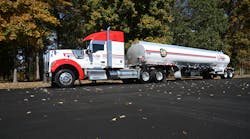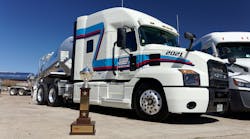THE Federal Motor Carrier Safety Administration (FMCSA) announces an operational test of procedural changes to the New Entrant Safety Assurance Program. The operational test began in July 2013 and will be in effect for up to 12 months.
It is applicable to new entrant motor carriers domiciled in the States of California, Florida, Illinois, Montana, and New York, as well as the Canadian Provinces contiguous to Montana and New York. The operational test procedures allow FMCSA to complete an off-site safety audit of eligible new entrant motor carriers that can demonstrate basic safety management controls by submitting compliance documentation as requested by FMCSA. The purpose of the operational test is to compare off-site and on-site new entrant safety audits in terms of resource allocation and subsequent safety performance of new entrant motor carriers.
The current New Entrant Safety Assurance Process was launched January 1, 2003. Under that program, approximately 34,000 safety audits are conducted annually. Significant FMCSA resources are required to travel to each motor carrier’s principal place of business to conduct these safety audits, according to FMCSA officials.
The vast majority of the safety audits have been completed within the 18-month statutory guideline previously established by Congress. However, the number of new entrant motor carriers entering the program continues to grow each year and FMCSA’s ability to complete all new entrant safety audits is significantly impacted by more stringent MAP-21 deadlines.
FMCSA officials say that approximately 70% of new entrant motor carriers pass their safety audit each year by demonstrating basic safety management controls in the areas of driver qualifications, hours of service, vehicle maintenance, accident register, and controlled substances and alcohol use and testing.
FMCSA page 2...
Unless roadside inspection results have indicated evidence of a violation requiring expedited action as described in 49 CFR 385.308, or a pattern of poor inspection scores severe enough to place the carrier in the high-risk category, the primary consideration for prioritizing safety audits is the number of months since the new entrant motor carrier received its US DOT Number. The Agency currently devotes the same resources in travel costs and staff time to on-site reviews of low-risk and higher-risk new entrant motor carriers.
The FMCSA believes there are opportunities to increase efficiency within the New Entrant Safety Assurance Program in a manner that will enhance safety and improve the Agency’s ability to meet the MAP-21 safety audit deadlines.
During the test, certain motor carriers are automatically flagged for an on-site new entrant safety audit at their principal place of business, as is current practice. These motor carriers include: Passenger carriers, carriers with evidence of roadside inspection activity while transporting a placardable quantity of hazardous materials; motor carriers with one or more Safety Measurement System (SMS) Behavior Analysis and Safety Improvement Category (BASIC) measurement above FMCSA’s intervention threshold; and motor carriers with evidence of an expedited action violation as described in 49 CFR 385.308.
All other new entrant motor carriers will be contacted by letter and asked to electronically submit legible copies of documentation to a new entrant safety audit Web site (http://ai.fmcsa.dot.gov/newentrant).
The requested documentation allows FMCSA to initiate the safety audit process remotely off-site through verification of compliance with basic safety management controls related to driver qualification, driver duty status, vehicle maintenance, the accident register, and controlled substances and alcohol use and testing consistent with 49 CFR 385.311.
FMCSA page 3...
The letter describes requested documents and explains that submission of these documents preclude the need for a safety audit at the new entrant carrier’s place of business. In addition, the letter explains that failure to submit the requested documentation or failure to respond to the letter will be treated as a refusal to undergo a safety audit and could constitute a failure to permit the safety audit in accordance with 49 CFR 385.337(b), which could result in revocation of the carrier’s registration and issuance of an order prohibiting interstate operations. Carriers that are unable to submit the requested documentation may submit an explanation in writing to FMCSA within 10 days from the service date of FMCSA’s request.
A new entrant safety auditor subsequently reviews the submitted documentation and either:
(1) Prepares a report to document that the motor carrier has passed the new entrant safety audit;
(2) Contacts the motor carrier to request additional documentation; or
(3) Schedules a safety audit at the motor carrier’s principal place of business as soon as practicable, based upon violations observed in the submitted documentation. ♦








